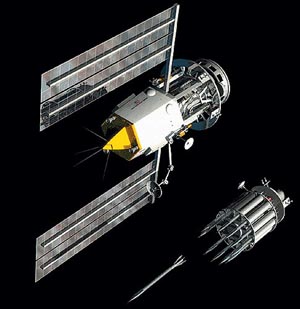This is my disclaimer:
I am a senior engineering student at a decent university (my program is in the top 20 in the country). I have only taken limited classes on aerodynamics and space flight mechanics (my major is something similar), however, I have come across this exact idea before in my classes.
My $0.02:
I can say that this weapon is not in existence, nor will it ever be any time soon. It was envisioned at one point by the Air Force (of which I am a member, AIR POWER!

) but discarded quickly because it isn't physically possible to have a material strong enough to survive re-entry at that geometry (the atomic weight is impossible because it would have to be insanely dense - they nicknamed the material 'unobtanium', and yes, this was before the movie, 'The Core').
What happens is that the force from the atmosphere during re-entry causes the rod to bend and collapse it along its length. By the time it gets through the atmosphere, most of the material is gone, or deformed to the extent that targeting it is difficult. (Basically, at the speeds it would be going through the upper atmosphere, the rod could be approximated by a beam with an incredible force at one end that buckles it.)
However, if it were to hit the Earth where you wanted, and it was in roughly the same shape as it started out as, you can imagine that there wouldn't be much left of what you hit. There would also be no nuclear radiation of any kind (I know this was said, but just to throw it in).
If it wasn't physically implausible that this worked, expense would do it in instantly. It costs roughly $100,000 (1980 dollars) to put 1 lb of material in space. Given the high density of each rod, the support structure, and the fuel needed to put it in a stable orbit, you're looking at too much money. Just use a smart bomb.
Final thoughts:
From the unit standpoint, I'm not saying no one should make this unit or use it. When I played civ3, I always added attack satellites to the game, as they definitely rock. However, just let it be known that this isn't going to happen anytime soon (until we can make a denser material), nor is anything like this in development.
Again, this is just my $0.02, feel free to rip me a new one.
-Smitty



 . But i imagine the dust plume to be high.
. But i imagine the dust plume to be high. .
. ) but discarded quickly because it isn't physically possible to have a material strong enough to survive re-entry at that geometry (the atomic weight is impossible because it would have to be insanely dense - they nicknamed the material 'unobtanium', and yes, this was before the movie, 'The Core').
) but discarded quickly because it isn't physically possible to have a material strong enough to survive re-entry at that geometry (the atomic weight is impossible because it would have to be insanely dense - they nicknamed the material 'unobtanium', and yes, this was before the movie, 'The Core'). 
 .
.